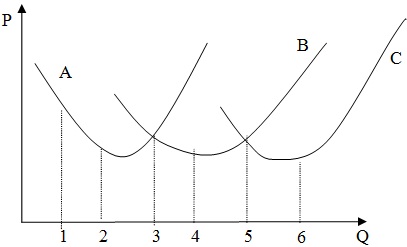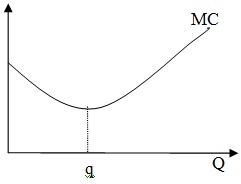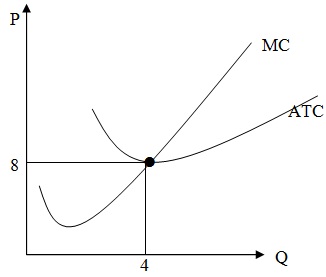Problem 1. A monopolist faces a demand curve given by the equation P = 15- 2Q. The marginal revenue curve is given by MR = 15 – 4Q. Marginal cost is given by the equation MC = Q. Average total cost is given by the equation ATC = Q/2. Assuming the monopolist maximizes profits, what will their profits equal?
a. $4.5
b. $18
c. $22.5
d. $27
Problem 2. A firm uses 10 units of capital and 10 units of labor to produce 20 units of output in one year. In the next year, using the same technology, they use 15 units of capital and 15 units of labor. In this year, they produce 25 units of output. We can say that this firm is exhibiting
a. Constant returns to scale
b. Diminishing returns to labor
c. Increasing returns to scale
d. Decreasing returns to scale
Problem 3. Which of the following statements is false?
a. In a perfectly competitive market, firms make zero economic profit in the long run equilibrium.
b. In a perfectly competitive market, the demand curve faced by a firm is downward sloping.
c. In a perfectly competitive market, firms produce where marginal revenue is equal to marginal cost.
d. In a perfectly competitive market, firms who are earning negative profits leave the market in the long run.
Problem 4. The domestic supply and domestic demand for coffee in a small closed economy is given by the following equations:
QD = -3P + 100
QS = 5P – 20
The world price of coffee is $14. If this small closed economy opens to trade in this market but implements a tariff of $4, what will the tariff revenue equal?
a. $0
b. $32
c. $96
d. $108
Problem 5. The average total cost curves for plants A, B, and C, each of which produce books, are shown in the following figure.

To produce 4 books, which plant is best?
a. Plant A
b. Plant B
c. Plant C
d. Plants A, B, or C are equally efficient at producing 4 books.
Use the following information to answer the next two questions.
Susan visits the state fair and rides the Ferris wheel several times. The following table shows her marginal or total utility from a given number of rides.
Number of Rides Total Utility (in utils) Marginal Utility (in utils)
1 10
2 24
3 34
4 7
5 46
Problem 6. Her marginal utility from the second ride is
a. 10 utils
b. 14 utils
c. 24 utils
d. 34 utils
Problem 7. Her total utility from riding the Ferris wheel four times is
a. 7 utils
b. 34 utils
c. 41 utils
d. 46 utils
Use the following information to answer the next three questions.
The following table gives cost information for a firm. Assume that labor is paid a constant wage, i.e. our firm is a price-taker in the labor market.

Problem 8. According to the information in the table,
a. x=7 units of output per unit of labor.
b. x=7/3 units of output per unit of labor.
c. x=10/3 units of output per unit of labor.
d. x=5 units of output per unit of labor.
Problem 9. According to the information in the table,
a. y= $16
b. y= $60
c. y= $12
d. y= $40
Problem 10. According to the information in the table,
a. z= $2 per unit of output.
b. z= $4 per unit of output.
c. z= $8 per unit of output.
d. z= $16 per unit of output.
Use the following information to answer the next two questions.
Using 2006 as the base year, the CPI in 2007 is 50.
Problem 11. What was the growth rate of prices between 2006 and 2007?
a. 0
b. -50%
c. 50%
d. 100%
Problem 12. The nominal price of a car was $20,000 in 2006 as well as in 2007. What was the real price of a car in 2007 using 2006 as the base year?
a. $10,000
b. $20,000
c. $30,000
d. $40,000
Problem 13. Suppose good A and good B are perfect complements. If the price of good A increases, then
a. the substitution effect is 0, and the change in demand is completely due to the income effect.
b. the income effect is 0, and the change in demand is completely due to the substitution effect.
c. both the substitution and the income effects are negative.
d. both the substitution and the income effects are positive.
Use the following information to answer the next two questions.
A monopolist faces a demand curve given by P = 10 – Q. The marginal revenue curve is MR = 10 – 2Q. The firm has a constant marginal cost of 6. If other firms were to enter the market, they would face the exact same costs as this firm. However, due to barriers to entry, no other firms can enter this market.
Problem 14. By how much will the price change if the barriers to entry in this market are eliminated and this market becomes perfectly competitive?
a. The price will stay the same
b. The price will increase by 2
c. The price will decrease by 2
d. The price will decrease by 6
Problem 15. Again assume that this firm has a monopoly in this market. What is the deadweight loss resulting from the firm being a monopoly as compared to the outcome under perfect competition?
a. $0
b. $2
c. $4
d. $6
Problem 16. Assume, for a firm, that marginal cost increases as the amount of output increases. Which of the following statements must be true?
a. The average total cost always increases as the amount of output increases.
b. The vertical difference between the average total cost and the average variable cost decreases as the amount of output increases.
c. Profit decreases as the amount of output increases.
d. Average variable cost decreases as the amount of output increases.
Problem 17. The market for a good is perfectly competitive. The marginal cost curve intersects the average total cost curve at $10. Marginal cost for a representative firm in this market is given by the equation MC = 2*q where q is the quantity produced by the representative firm. Market demand for this good is given by the equation P = 200 – 2*Q where P is the market price and Q is the market quantity. How many firms will be in this market in the long run?
a. 1 firm
b. 5 firms
c. 19 firms
d. 50 firms
Use the following information to answer the next two questions.
The following gives the domestic demand and domestic supply curves for sweaters in a small closed economy.
QS = 2P – 200
QD = - (1/2)P+ 300
Problem 18. Suppose this small closed economy is open to free trade and they import 125 sweaters. What is the world price for sweaters?
a. $150
b. $162.50
c. $225
d. $350
Problem 19. Suppose the government issues a quota to protect domestic producers. With the quota, domestic producers supply 120 sweaters. What is the amount of the quota?
a. 100 sweaters
b. 120 sweaters
c. 220 sweaters
d. 250 sweaters
Use the following information to answer the next three questions.
Firm A produces potato chips and the following table provides information about Firm A's total cost.
Number of Workers Quantity Total cost
0 0 30
1 2 42
2 5 51
3 7 65
4 8 75
5 9 90
The potato chip industry is perfectly competitive. The market price is initially $10.
Problem 20. Assume Firm A picks a quantity to maximize their profits. What will Firm A’s profits equal?
a. $0
b. $5
c. $70
d. $80
Problem 21. Which of the following statements is true?
a. Firm A should shut down immediately.
b. Firm A should produce in the short run but shut down in the long run.
c. Firm A should produce in the short run and in the long run.
d. Firm A should not produce in the short run but should produce in the long run.
Problem 22. Suppose that a number of potato chip-producing firms enter the industry in the long run and the market price decreases to $7. Which of the following statements is true?
a. Firm A should shut down immediately.
b. Firm A should produce in the short run but shut down in the long run.
c. Firm A should produce in the short run and in the long run.
d. Firm A should not produce in the short run but should produce in the long run.
Problem 23. Arthur Dent earns $52, all of which he spends on shirts and shoes. He buys 5 shirts and 6 pairs of shoes. After buying these goods, his marginal utility of buying another shirt is 12 and his marginal utility of buying another pair of shoes is 3. Shirts cost $8 each and a pair of shoes costs $2. It can be concluded that Arthur
a. is spending too much money on shirts and not enough money on shoes.
b. is spending too much money on shoes and not enough money on shirts.
c. is spending his income on shirts and shoes in such a way as to maximize his utility.
d. can feasibly increase his utility by buying more shirts and more shoes.
Problem 24. The following describes 4 different markets:
Market A: The good sold in this market is a homogenous good. Firms can easily enter and leave the industry. There are a large number of buyers and a large number of sellers. One of the sellers controls 52 percent of the market.
Market B: The good sold in this market is a homogenous good. Firms can easily enter and leave the industry. There are a large number of buyers and sellers. One of the consumers buys 60 percent of what is sold in the market.
Market C: The good sold in this market is a homogenous good. Firms can easily enter and leave the industry. There are four buyers and four sellers in the market.
Market D: The good sold in this market is a homogenous good. Firms can easily enter and leave the industry. There are a large number of buyers and a large number of sellers. No buyer or seller has a large market share.
Which of these markets most closely resembles a perfectly competitive market?
a. Market A
b. Market B
c. Market C
d. Market D
Problem 25. Bob spends all of his money on apples and oranges. The price of apples doubles and the price of oranges doubles. At the same time, Bob’s income doubles. What will happen to Bob’s budget constraint?
a. Bob’s budget constraint will double.
b. Bob’s budget constraint will quadruple.
c. Bob’s budget constraint will move inward.
d. Bob’s budget constraint will not change.
Problem 26. Assume the marginal cost function for a firm is described by the following curve:

In the figure, q is the quantity at which marginal cost attains it minimal value. Suppose you know that the shutdown point occurs at a quantity greater than q and that fixed costs for this firm are greater than 0. Suppose q1 is defined as the quantity where average total cost attains its minimal value. Then we know that
a. q1b. q1>q
c. q1=q
d. we cannot determine the relationship between q1 and q from the information given in the question
Problem 27. Which of the following statements is true for a small open economy?
a. A quota is ineffective if the amount of the quota is greater than the number of goods imported when there is no quota.
b. Quotas are more efficient than tariffs.
c. A tariff is ineffective if it is makes the world price higher than the domestic price.
d. Tariffs are more efficient than quotas.
Problem 28. Mario likes to play video games. He is experiencing diminishing marginal utility, but his marginal utility remains positive. What can we say about Mario’s total utility?
a. Mario’s utility is increasing at an increasing rate
b. Mario’s utility is increasing at an decreasing rate
c. Mario’s utility is decreasing at an increasing rate
d. Mario’s utility is decreasing at an decreasing rate
Problem 29. Average variable cost attains its minimum value when
a. marginal cost is at its minimum value.
b. the gap between average variable cost and marginal cost is largest.
c. marginal cost equals average variable cost.
d. average total cost attains its minimum value.
Problem 30. Maude spends all of her income on books and DVDs. She thinks that books and DVDs are perfect substitutes: one book is just as good as one DVD. Suppose that books cost $4 each and DVDs cost $5 each. Maude has an income of $120. How should she spend her income to maximize her utility?
a. Maude should buy 30 books.
b. Maude should buy 24 DVDs.
c. Maude should buy 15 books and 12 DVDs.
d. Maude should buy 20 books and 8 DVDs.
Problem 31. Assume a firm is a price taker in the labor market (that is the firm pays its workers the market determined wage rate). Which of the follows statements is false?
a. If the price of labor doubles in the labor market, the marginal cost will double for all positive levels of production.
b. If the price of labor doubles in the labor market, then the average total cost will double for all positive levels of production.
c. If the price of labor doubles in the labor market, the average variable cost will double for all positive levels of production.
d. If the price of labor doubles in the labor market, the variable cost will double for all positive levels of production.
Use the following information to answer the next two questions.
The following figure shows the cost information for a representative firm selling basketballs in the perfectly competitive market for basketballs.

Problem 32. Basketballs are currently selling for $10. Which of the following statements is true?
a. Firms in this market are currently earning negative profits.
b. Firms in this market are currently earning positive profits.
c. Firms in this market are currently earning zero profits.
d. We cannot determine the profits earned by firms in this market without the market demand curve.
Problem 33. Assume that there are originally 12 firms in this perfectly competitive market. Assume the demand curve for basketballs is given by the equation P = -(1/2)Q + 50. What will happen in the long run?
a. 5 firms will enter the market
b. 5 firms will leave the market
c. 9 firms will enter the market
d. 9 firms will leave the market